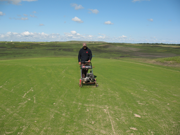
Features
Profiles
Rebuilding relocated Southwood had its fair share of challenges, superintendent tells his peers
November 27, 2014 By Mike Jiggens
By Myron Love
Winnipeg’s Southwood Golf & Country Club is the oldest golf club in the province. While the club celebrated its 120th birthday this year, course superintendent Dustin How, speaking at the Manitoba Golf Superintendents Association’s annual general meeting in November, noted that the club’s origins actually go back to 1894.
In 1922, How noted, Southwood opened for play at what was to be its home right up until four years ago. But the club directors didn’t keep to their now former location all those years by choice, as he pointed out. As far back as 1966, the club management was looking to relocate.
“We had many problems with our former location near the University of Manitoba,” How said, citing concerns such as lack of room for expansion, the fact that golfers had to cross busy roads (to the university) to get from one part of the course to another, a lack of parking, a topography that was difficult to drain—especially after a heavy rain—and a huge problem with riverbank stability.
“Major upgrades were needed,” How said. “We had different green compositions. The bunkers were overdue for renovations because of silt buildup from the Red River. We had a major problem with our irrigation system. And our pump station failed in the spring of 2011.”
While issues related to cost, zoning and some opposition among the members spiked earlier plans to move, an offer from the University of Manitoba to buy the course land for $10 million in addition to the work that was needed to improve the course and clubhouse made this decision to move rather easy.
In 2007, How reported, Southwood bought 297 acres in St. Norbert, a bedroom community just south of Winnipeg. The club hired golf course designer Tom McBroom to design their course. The new holes and fairways were constructed beginning in 2008, a clubhouse was built in 2009 and the course opened for business in July 2011.
In his presentation to the association, How described the challenges of building a new golf course from scratch.
“We used 600,000 cubic yards of earth to shape our new course,” he said. “There are five ponds on the course—each about 20 to 25 feet deep. The 600,000 yards of earth we removed to shape the course created the ponds. In addition to the 600,000 yards of earth, another 100,000 yards of topsoil were stockpiled and then replaced on the tees, fairways and roughs.
“We used three scrapers, a D8, and D7 dozer to remove and relocate the soil.”
The first problem that the course superintendent and his team encountered was the nature of the soil. The new course was being built on Red River gumbo lurking beneath the black topsoil. Heavy rains in 2009 caused the soil to turn to thick mud.
“The topsoil was very difficult to work with,” How said. “We tried various ways to break it down. We tried different pieces of equipment without success. Finally, we rented a 10-foot set of agricultural discs to spin the soil. It took weeks to break it down into half-inch to one-inch balls of rocky soil. We ended up with 10 inches of topsoil for the tees, six inches for the fairways and four inches for the rough.”
How reported that he and his crew didn’t add any topsoil to the fescues. The fescues had a high salt content and very little organic matter, he noted.
As to drainage, How reported that there are 210 catch basins feeding into smooth, double-walled piping, installed throughout the course, most of them dug in 2008. All the water runs off either into onsite ponds and then to the nearby LaSalle River or into a ditch alongside the nearest road.
“We tried to cap the drain lines as soon as possible to keep out sediment,” How said.
How noted that there are 880 irrigation heads on the property. Around the greens, there are double heads. The irrigation piping is made of high density polyethylene. The typical pipe depth is two to three feet.
“In mid-summer,” he said, “we pump 300,000 to 400,000 gallons a night.”
The 100 acres of fescue aren’t irrigated, he noted.
The greens were constructed, he said, using fine sand as the soil base with a cover of creeping bentgrass.
The tees were built with an eight to 10-inch base of native topsoil.
“If we were to do this again, we would use a blended soil for the tees,” How noted. “They would be easier to grade that way.”
He reported that there are 76 bunkers on the site.
“We used a 210 Volvo excavator for the rough grade and John Deere 75 and Kubota 121 excavators to finish grade and place the topsoil,” he said. “The sand depth is four inches to six inches.
“Bunker liners would have been good, but we couldn’t afford them. We tried to save the finer topsoil for the bunker fingers.”
The cart paths were made of gravel and geotextile fabric. The paths are eight feet wide. For the tee to green paths, wood chip material was used.
The course management team used hydroseeders to seed the greens complexes, bunker complexes and tees. Close to 200 acres of land were seeded and no sod was used during the construction.
The new course opened in July, 2011, and, earlier this year, hosted two national golf championships—the Canadian Universities Championships and the Canadian Men’s Amateur Championship which it co-hosted.
Print this page